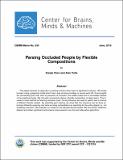| dc.contributor.author | Chen, Xianjie | |
| dc.contributor.author | Yuille, Alan L. | |
| dc.date.accessioned | 2015-12-11T22:21:37Z | |
| dc.date.available | 2015-12-11T22:21:37Z | |
| dc.date.issued | 2015-06-01 | |
| dc.identifier.uri | http://hdl.handle.net/1721.1/100199 | |
| dc.description.abstract | This paper presents an approach to parsing humans when there is significant occlusion. We model humans using a graphical model which has a tree structure building on recent work [32, 6] and exploit the connectivity prior that, even in presence of occlusion, the visible nodes form a connected subtree of the graphical model. We call each connected subtree a flexible composition of object parts. This involves a novel method for learning occlusion cues. During inference we need to search over a mixture of different flexible models. By exploiting part sharing, we show that this inference can be done extremely efficiently requiring only twice as many computations as searching for the entire object (i.e., not modeling occlusion). We evaluate our model on the standard benchmarked “We Are Family" Stickmen dataset and obtain significant performance improvements over the best alternative algorithms. | en_US |
| dc.description.sponsorship | This work was supported by the Center for Brains, Minds and Machines (CBMM), funded by NSF STC award CCF-1231216. | en_US |
| dc.language.iso | en_US | en_US |
| dc.publisher | Center for Brains, Minds and Machines (CBMM), arXiv | en_US |
| dc.relation.ispartofseries | CBMM Memo Series;034 | |
| dc.rights | Attribution-NonCommercial 3.0 United States | * |
| dc.rights.uri | http://creativecommons.org/licenses/by-nc/3.0/us/ | * |
| dc.subject | Occlusion | en_US |
| dc.subject | Inference | en_US |
| dc.subject | Machine Learning | en_US |
| dc.subject | Artificial Intelligence | en_US |
| dc.title | Parsing Occluded People by Flexible Compositions | en_US |
| dc.type | Technical Report | en_US |
| dc.type | Working Paper | en_US |
| dc.type | Other | en_US |
| dc.identifier.citation | arXiv:1412.1526 | en_US |
